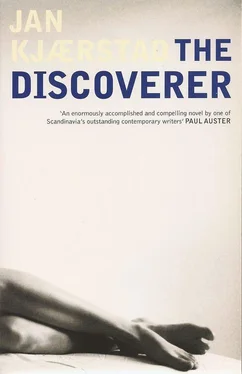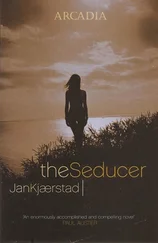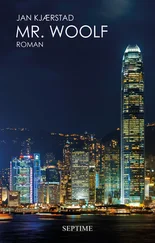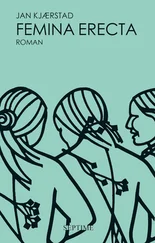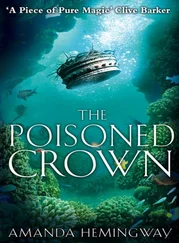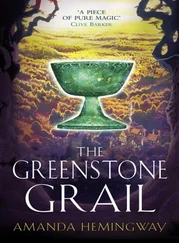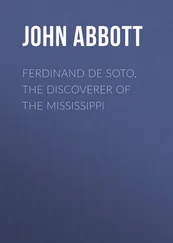Jan Kjaerstad - The Discoverer
Здесь есть возможность читать онлайн «Jan Kjaerstad - The Discoverer» весь текст электронной книги совершенно бесплатно (целиком полную версию без сокращений). В некоторых случаях можно слушать аудио, скачать через торрент в формате fb2 и присутствует краткое содержание. Год выпуска: 2009, Издательство: Arcadia Books, Жанр: Современная проза, на английском языке. Описание произведения, (предисловие) а так же отзывы посетителей доступны на портале библиотеки ЛибКат.
- Название:The Discoverer
- Автор:
- Издательство:Arcadia Books
- Жанр:
- Год:2009
- ISBN:нет данных
- Рейтинг книги:5 / 5. Голосов: 1
-
Избранное:Добавить в избранное
- Отзывы:
-
Ваша оценка:
- 100
- 1
- 2
- 3
- 4
- 5
The Discoverer: краткое содержание, описание и аннотация
Предлагаем к чтению аннотацию, описание, краткое содержание или предисловие (зависит от того, что написал сам автор книги «The Discoverer»). Если вы не нашли необходимую информацию о книге — напишите в комментариях, мы постараемся отыскать её.
The Discoverer — читать онлайн бесплатно полную книгу (весь текст) целиком
Ниже представлен текст книги, разбитый по страницам. Система сохранения места последней прочитанной страницы, позволяет с удобством читать онлайн бесплатно книгу «The Discoverer», без необходимости каждый раз заново искать на чём Вы остановились. Поставьте закладку, и сможете в любой момент перейти на страницу, на которой закончили чтение.
Интервал:
Закладка:
I had laughed at Viktor’s discourses on The Cantos , Ezra Pound’s megalomaniac attempt to construct a different sort of unity out of fragments. But some years later, by which time Viktor — I almost envied him — had found an impenetrable hiding place in an institution, there I was myself, striving to draw up a new map of human knowledge, a Project X which probably had more in common with the American bard’s euphoric songs than I liked to think.
My study of — I might almost say: worship of — the cross spider’s wheel web had inspired me also to try working breadthwise and from here it was only a short step to a more spatial perspective. I left my seat in the reading room and took instead to roaming around the campus. By studying the relationship of the university buildings to one another, which departments occupied which floors, I hoped I might discover something about the relative order of the various disciplines. Why were the buildings housing Sociology and Physics situated so far apart? And why did Philosophy occupy the floor above Theology in the Niels Treschow building?
It may well have been these strolls around the campus which prompted me to move base to the College of Architecture. Because my aim was not to become an architect; I was still looking for some means of organising all human knowledge — something better than the stunting 534: Sound and related vibrations, 535: Light and paraphotic phenomena, 536: Heat and thermodynamics; what I sought was a set-up which would make the most of the potential stored within the knowledge common to all of us, hence enabling us to take a cognitive leap forward. The first months there seemed especially promising. I had been spurred to apply the principles of floor-planning to my work. I grouped the sheets of paper I had spread out on the floor of the living room in Hegdehaugsveien as if the main classes and the subdivisions listed on them were rooms in a large house, or private and public premises in a metropolis.
This soon had to give way, however, to a more ambitious plan — this too architectonically inspired — in which I tried to find a dimension of depth in the connecting tissue of the arts and sciences. I tore up the sheets of paper on the floor. I started working with larger sheets, progressed from miniatures to massive canvases, so to speak. The living room was now full of transparent plastic tablecloths suspended from the ceiling, closely covered with subject headings. It looked rather like a lot of bookcases sitting one behind another, the only difference being that these you could see through, see all the way to the very back. Sometimes I had the impression that I was once more on a vaporetto on the Grand Canal; I felt as though I was gliding past a succession of transparent, almost identical palazzo façades. On the first sheets I had listed the more concrete main classes and subjects; the further back you went the more abstract they became. Each heading had, therefore, possible links running in countless directions. I suddenly perceived, for example — with the taste of gooseberries in my mouth, as it happens — that there might be a connection between palaeontology’s interest in fossilised dinosaur bones and modern neurology’s theories regarding the reptilian layer of the brain. Often, when I was standing looking at these transparent tablecloths, contemplating the groups of subjects hanging in layers, one behind the other, I felt something close to a new state of mind, as though my vision and my thoughts were now in tune with an awareness I had always possessed.
What Margrete liked better than anything else was to walk around the garden, barefoot and without an umbrella, when it rained in the summer. She was the sort of person who could set such store by a fine dinner service that she would stroke it with her fingers. Sometimes she would kiss me just to enjoy the sound of a kiss. That was the best sound in the world, she said: the sound of a kiss. I never made any allowance for such knowledge, such wisdom, when I was struggling with my Project X.
I have never been all that interested in the so-called explorers, all except one: Fernão de Magalhães, or Ferdinand Magellan as he was known to us in school. True he was killed in the Philippines, so he never made it back to his starting point in Spain himself, but it was his initiative and vision which brought about the first circumnavigation of the Earth. No one combined strength of will with cosmographic perception and nautical know-how the way Magellan did. The others hit upon a bit of land here and there, but it was Magellan who tied a string around it all, binding all of the individual discoveries together, threading the pearls neatly onto a strand so that they formed a circle. There could no longer be any doubt: the world was round.
There were times when I thought of my Project X as a Magellanic voyage. Like Magellan I wanted to find other routes, new straits to sail through. I dreamed, not least, of an outcome every bit as deep-reaching as his: a completely new view of the world. Magellan showed the people of his day that the world was bigger than they thought.
I soon came to look upon the plastic tablecloths filling the living room as sails, especially when I aired the room and the sheets flapped gently in the draught. I was not in Hegdehaugsveien at all, I was on board my Victoria , the only one of Magellan’s ships to make it home. Magellan sailed round the Earth. I wished to sail round, to encircle reality. When I read those layers upon layers of words, I felt a breeze blowing inside me, or rather, I felt as if something were being opened up, as if I were about to acquire more of that profound insight of which, all my life, I had known myself to possess only a subset. Meanwhile, the work, the thinking, was taking its toll on me. It is said that while crossing the Pacific Magellan’s men lived on worm-eaten biscuits and dirty, foul-smelling water, before they took to eating rats and sawdust, and chewing hide ripped off the timbers. During the Pacific Ocean phase of the Project I led an equally spartan, if not quite so drastic existence. Leonard’s Italian cuisine was a thing of the past. If I did get round to eating anything, I tended to fall back on Spaghetti à la Capri, which I did not even bother to warm, just spooned straight from the tin. It reminded me of my childhood, when the only provisions we needed for a walk in the forest was a stock cube to lick.
The actual crossing of ‘il Pacifico’, a totally unknown area, was Magellan’s greatest achievement. They thought it would only take a few days to sail from the New World, America, to the Moluccas, the centre of the oriental spice trade, instead it took almost four months. Magellan could almost be said to have discovered the Pacific, its vast scale. I too wanted to find something like that: an unknown, or underestimated sea. In selecting the main classes for my new system I gave priority to those subjects pertaining to the mind or things immaterial. I aimed to disentangle a hidden, as yet unrealised, meaning from the world. Fold out reality. A few of today’s particle physicists maintain that we can have no conception of the greater part of the universe simply because it is comprised of a form of matter so essentially different from anything we can imagine. I know it sounds strange, not to say crazy, but I believe that during the most transparent phases of my Project I was on the track of something like that.
Once, I was waiting for Margrete outside a cinema. She took a taxi from work. I observed her through the dark, tinted window as she was paying the driver. I could only just make out her face. The thought struck me that she was trapped inside a black crystal. That I would never be able to break through to her.
The longer I stayed in that room, among those transparent panels covered in writing, the more the feeling I had had ever since studying the spider’s web was confirmed — a hunch which was reinforced by the notion of circumnavigating the world: I ought to arrange the subjects in a circle. Like a wheel.
Читать дальшеИнтервал:
Закладка:
Похожие книги на «The Discoverer»
Представляем Вашему вниманию похожие книги на «The Discoverer» списком для выбора. Мы отобрали схожую по названию и смыслу литературу в надежде предоставить читателям больше вариантов отыскать новые, интересные, ещё непрочитанные произведения.
Обсуждение, отзывы о книге «The Discoverer» и просто собственные мнения читателей. Оставьте ваши комментарии, напишите, что Вы думаете о произведении, его смысле или главных героях. Укажите что конкретно понравилось, а что нет, и почему Вы так считаете.
